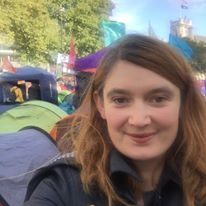Since the start of lockdown. I have been to my local wood every day. However, just as the anemones and bluebells are making their yearly appearance, I feel that dreaded tickle at the back of my throat.
It is not a sinister cough – phlegmy and fruity-sounding, without any other symptoms. But the advice online is clear. Any respiratory symptoms mean a 7-day isolation.
And so I have a morose afternoon to waste in my back garden. The day is tauntingly hot, and I am more aware than usual that my garden is not beautiful. We have had a lot of work to do in the house over the last few years, which means the outdoors has largely been neglected.
Yet lockdown has taught me that beauty can be found in even the most unpromising of places, if you are prepared to concentrate fiercely on fragments.
I scrutinize each beauty I encounter, turning it over like a Baoding meditation ball in the palm of my mind.
Above the mess of broken pot plants, the new azalea buds have emerged. Sticky and tacky to the touch, most are as tightly clenched as praying hands, but one has opened to reveal a promise of shocking scarlet.
Birds are singing. Unfortunately, I have never learned the art of distinguishing them. One is almost siren-like in its insistence and volume: get IT, get IT, get IT.
Get what, though? There is no sense of urgency on this unusually hot April day.
Even the Orange-tip butterfly I catch sight of near a flower bed seems a little lazier than I’d expect. I follow it from leaf to leaf. until it finally flutters over the fence.
Another bird joins the Siren. Only its song is a sweet warble, low and wavering. I realise what I miss more than anything is the sound of fresh running water: a river, the sea. I’d even settle for the lapping of a calm lake at my feet. But I am not likely to hear anything of the sort for months.
I shade my eyes and try to locate the birds in the silver birch above. But, against the glare of the sun and the great expanse of magnanimous blue above, all I can make out are the catkins, dangling and quivering in the breeze.
I am about to give up and go back indoors. I feel a flurry of coughing and spluttering about to come on, and I do not want to alarm the neighbours.
Just as I am preparing to make my way down the stone steps to the conservatory, I see it: a hoverfly, mid-air.
Nothing especially strange about that, of course. What Is extraordinary is its stillness.
I have seen a kestrel hover above its prey, impressively steady against the wind. But even that bird will betray itself with the odd flap of the wings and a few quivering dips.
The hoverfly’s wings, of course, are moving – so fast, in fact, that they look like tiny, diaphanous veils.
Suppressing my cough, I move round it, very slowly.
It is the most uncanny sight, like one of those bullet time sequences in an action film. Except this bullet has bright bands, not all that dissimilar to the yellow chalk enigmas my daughter has scrawled on the stone slabs nearby.
It buzzes. It is not the drowsy, insouciant hum of the bees in the quince bush nearby, but far higher-pitched.
One of my first memories is of being stung by a bee at the age of three. It had the same black and yellow stripes as the hoverfly, Nature’s STAY AWAY sign, not comprehended by a toddler who associated fluff and colour with cuddly toys.
I don’t remember the jolt of pain, only the tears afterwards. And buzzing still arouses a residual fear in me, as it does in most adults. But, now, fascinated, I quell it completely.
The insect’s antennae are stubby, like the incipient green shoots of vegetables growing nearby. Its abdomen is rather more bulbous than a wasp’s.
I feel an odd affinity with this tiny creature, presenting such a perfect exemplar of motionless, while buoyed by the frenetic activity of its single pair of wings.
Does it consciously will those gossamer wings to move, as I now bid my clumsy, heavy feet to shuffle fractionally closer towards it? Or is it more like the spasms of the muscles in my heart, clenching and unclenching, beyond my control or awareness?
Suddenly, a similar spasm of one such muscle in my chest releases that cough I’ve been holding back for so long.
The spell is broken. The hoverfly darts to the quince bush. I jog over to it, but, of course, I cannot not find it.
It has given me a lesson in stillness, that exquisite little dark of energy.
I now have a lack of movement of my own to maintain, like so many other people in this country and all over the world.
Good luck everyone. We must all hover a while. May the wings of your mind bear you aloft.

Anna holds an MA in Creative Writing with Distinction from the University of East Anglia. Her stories have been published in Mslexia, MIR Online and Paper Cuts, as well as a variety of anthologies. She focuses on climate change fiction, or ‘cli fi’ and her story ‘A Reconciliation’ recently won the Climaginaries Anthroposcenes short story contest. She lives with her husband and two children in Croydon. She tweets under @orridge_anna
[registration_form]
Entry E mentions Issac Newton and violet. How many know he split light into its spectrum and back to white light using prisms while isolated near Grantham during the great plague.